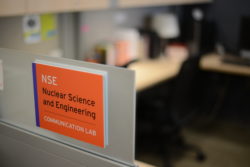 The NSE Communication Lab was launched in 2014 to fill the educational gap between the technical rigor of MIT and the communication needs revealed by alumni and employer surveys.
The NSE Communication Lab was launched in 2014 to fill the educational gap between the technical rigor of MIT and the communication needs revealed by alumni and employer surveys.
The NSE Comm Lab selects and trains graduate students from within NSE to serve as communication coaches, or Communication Fellows. These Fellows meet one-on-one with students and postdocs who wish to improve their technical outputs such as lab reports, presentations, and fellowship applications. This field-specific, peer-to-peer model originated in the Department of Biological Engineering, and was tailored to meet the specific needs of NSE. Not only does the Comm Lab offer many advantages over a communication course[1] but it can also be adapted for different STEM communities.[2]
We describe our educational model in depth through the Communication Lab Summer Institute. Here are a few highlights about our practices:
A peer-to-peer model
The Fellows serve as “trusted guides.” When students move into increasingly specialized disciplines, they are more likely to trust the feedback they receive from someone with a similar technical background. According to a 2015 survey, 85% of NSE grad students believe it is “essential” that they receive communication support from a content expert, defined as someone who understands their field (n=46).
Just-in-time service
Students learn new skills just when they need them. This is different from a class where students may learn how to produce a manuscript, but won’t use those skills for an actual journal article until months (or years) later. Here, students work on tasks that are real and relevant to them in that moment, so they are more invested in the learning process.
 Learning by doing
Learning by doing
Students learn best when they come up with their own answers. To create this environment, Fellows use strategic prompts to steer the conversation in a direction that needs attention. For a grad school application, they may ask that the student establish a match between them and their target program. For a presentation, they may ask who’s going to be in the room (Funders? Just the thesis committee? The whole department?). Students do most of the work and, although Fellows may offer ideas, the students always make the final decision.
˜˜˜
A difference in the classroom
Student and faculty surveys show that the Comm Lab model helps to improve both skills and confidence. In 22.033 (an undergraduate course), the instructor found evidence that students gained transferable skills through the Comm Lab (see figure). As a result, several NSE instructors have been offering a three-day deadline extension to students who work with a Fellow on their writing assignments. (Instructors also note that it takes them less time to grade those papers!)
Publications about the Comm Lab
[1] Hanson, A. J., Lindahl, P., Strasser, S. D., Takemura, A. F., Englund, D. R., and Goldstein, J. “Technical communication instruction for graduate students: The Communication Lab vs. a Course,” in Proceedings of the 2017 ASEE Annual Conference, Columbus, Ohio. Jun. 2017. (link)
[2] Summers, S., Olivier-Mason, A.J., Dang, M., Chien, D.M. “Experiments in the Communication Lab: Adaptations of the Comm Lab Model in Three Institutions,” in Proceedings of the 2019 ASEE Annual Conference, Tampa, Florida, Jun. 2019. (link)
